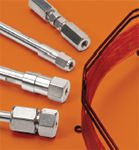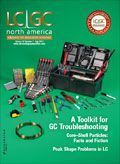Gradient HPLC for Reversed-Phase Separations
LCGC North America
Gradients can provide improved peak shape, higher efficiency, and sometimes altered selectivity and improved resolution.
Isocratic high performance liquid chromatography (HPLC) for reversed-phase separations, while both convenient and robust, has inherent issues, especially when dealing with compounds whose polarity, hydrophobicity, or extent of ionization vary widely. Common problems include
- poor resolution of early eluted peaks,
- increased peak width (potentially resulting in poor resolution and sensitivity) for later-eluted analytes resulting from peak broadening caused by diffusion of the analyte band,
- the inability to cope effectively with analytes having a broad range of hydrophobicity (log P or log D), often resulting in unnecessarily long analyses, and
- contamination of columns by strongly retained components.

Gradient HPLC can help overcome some of these issues and provide improved peak shape, higher efficiency, and sometimes altered selectivity and improved resolution, especially for later-eluted peaks.
Gradients in reversed-phase HPLC typically involve the on-line (dynamic) mixing of solvents to achieve a steady increase in the organic solvent (typically methanol or acetonitrile) over the course of the analysis, thus increasing the elution strength of the eluent over time. Buffer strength or pH gradients, although more unusual, also may be used, especially with stationary phases capable of undergoing electrostatic interaction with the analyte.
Three parameters are required to specify an eluotropic strength gradient in reversed-phase HPLC: initial percentage of solvent B (%B), where solvent B is usually the organic or "strong" solvent, final %B, and gradient time (tG) over which the transition in eluotropic strength will be achieved. In practice, there are several other very important parameters to consider:
Isocratic hold: A period within the gradient in which the eluent composition is held at the initial %B. This achieves a degree of analyte focusing but also crucially enables easy transfer of gradients between different instruments based on the specific instrument gradient dwell volume (VD).
Purge time: Usually achieved using a short ballistic gradient ramp to high %B to elute highly retained components (of no analytical interest) from the column. There may be an isocratic hold at this composition to ensure elution of all analytes and strongly absorbed components of no analytical interest.
Conditioning: Returning the column to the initial gradient composition. In practice, with modern instruments, this step is programmed to occur very rapidly.
Equilibration: The time taken to ensure the whole of the analytical column is returned to the initial gradient composition. This is an important step and if not properly considered can lead to retention time and quantitative variability. Most manufacturers will recommend between 5 and 10 column void volumes for proper equilibration. A very rough approximation for the column void volume in milliliters is VM = Ldc2 (0.0005), where L is the column length and dc the column diameter, both in millimeters.
System gradient dwell volume (VD): To perform gradient HPLC analysis and to transfer methods between instruments successfully, it is important to know VD. The best gradient methods have an isocratic portion at the beginning of the profile that is at least as long as the gradient dwell volume. Refer to your manufacturer for this value or an appropriate method for empirical determination.
In gradient HPLC, retention behavior is somewhat different from that in isocratic HPLC. At the beginning of the analysis, when the mobile-phase strength is low, the analyte is partitioned wholly into the stationary phase (or "focused") at the head of the column and will not move through the column at all.
As the mobile-phase strength increases, the analyte will begin to partition into the mobile phase and move along the column. As the mobile-phase strength increases continuously, the rate at which the analyte moves along the column subsequently increases and the analyte "accelerates'" through the column.
At some point within the column, the analyte may be wholly partitioned into the mobile phase, and will be moving with the same linear velocity as the mobile phase. The point at which this occurs depends upon the nature of the analyte and its interaction with the stationary phase material.
As the rate at which the analyte elution changes during gradient HPLC, the retention factor (k) used for isocratic separations is not applicable. Instead we use an "average" retention value, k*, or the retention factor of the analyte as it passes the midpoint of the column. Most analytes will be moving at the same rate as they pass the midpoint of the column and hence the retention factors for all analytes in gradient HPLC are very similar.
In gradient elution, the peaks are narrow with almost equal peak widths. All compounds accelerate through the column and thus are eluted at a high velocity. The retention time difference between compounds is largely a consequence of the percent organic modifier at which each starts to accelerate.All compounds should have approximately the same speed when they leave the column. Further, the front and tail of an analyte band reside in slightly different concentrations of organic modifier — the velocity of the tail is slightly higher than the heart of the band and vice versa for the front, which results in peak focusing. The narrow peaks obtained in gradient elution generally provide better detection limits and higher loading capacities.

Accelerating Monoclonal Antibody Quality Control: The Role of LC–MS in Upstream Bioprocessing
This study highlights the promising potential of LC–MS as a powerful tool for mAb quality control within the context of upstream processing.
Using GC-MS to Measure Improvement Efforts to TNT-Contaminated Soil
April 29th 2025Researchers developing a plant microbial consortium that can repair in-situ high concentration TNT (1434 mg/kg) contaminated soil, as well as overcome the limitations of previous studies that only focused on simulated pollution, used untargeted metabolone gas chromatography-mass spectrometry (GC-MS) to measure their success.
Prioritizing Non-Target Screening in LC–HRMS Environmental Sample Analysis
April 28th 2025When analyzing samples using liquid chromatography–high-resolution mass spectrometry, there are various ways the processes can be improved. Researchers created new methods for prioritizing these strategies.
Potential Obstacles in Chromatographic Analyses Distinguishing Marijuana from Hemp
April 28th 2025LCGC International's April series for National Cannabis Awareness Month concludes with a discussion with Walter B. Wilson from the National Institute of Standard and Technology’s (NIST’s) Chemical Sciences Division regarding recent research his team conducted investigating chromatographic interferences that can potentially inflate the levels of Δ9-THC in Cannabis sativa plant samples, and possible solutions to avoid this problem.

.png&w=3840&q=75)

.png&w=3840&q=75)



.png&w=3840&q=75)



.png&w=3840&q=75)











